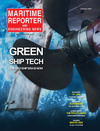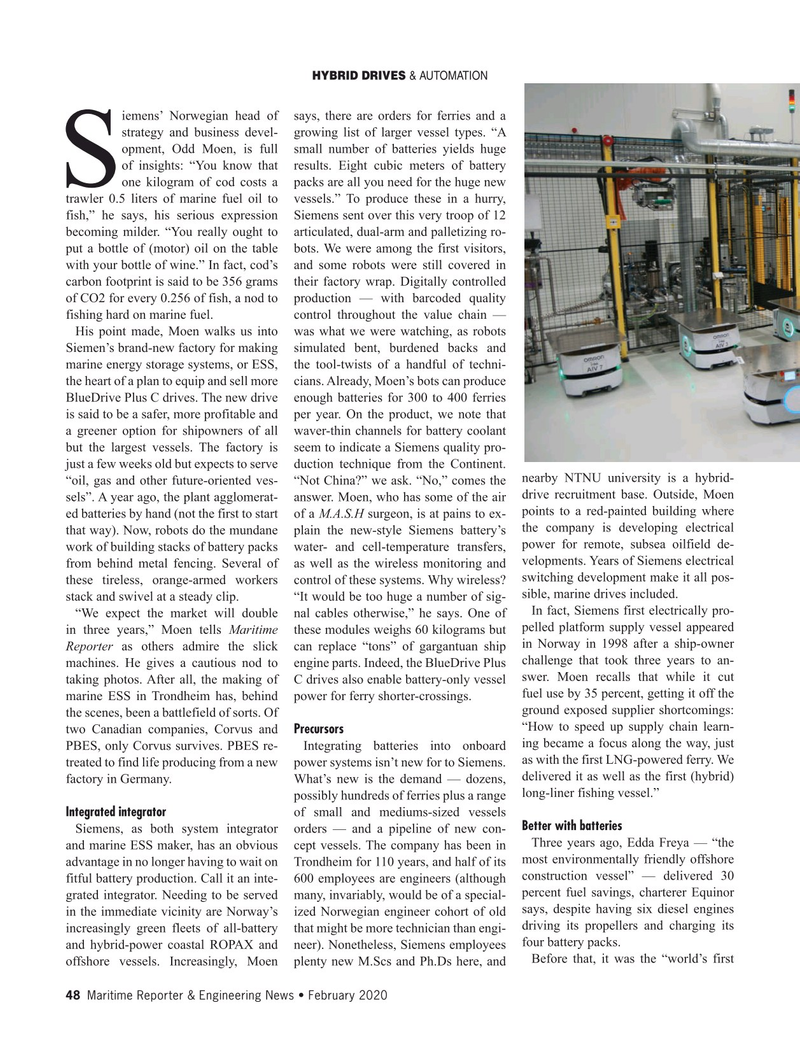
Page 48: of Maritime Reporter Magazine (February 2020)
Green Ship Technology
Read this page in Pdf, Flash or Html5 edition of February 2020 Maritime Reporter Magazine
HYBRID DRIVES & AUTOMATION iemens’ Norwegian head of says, there are orders for ferries and a strategy and business devel- growing list of larger vessel types. “A opment, Odd Moen, is full small number of batteries yields huge of insights: “You know that results. Eight cubic meters of battery
Sone kilogram of cod costs a packs are all you need for the huge new trawler 0.5 liters of marine fuel oil to vessels.” To produce these in a hurry, fish,” he says, his serious expression Siemens sent over this very troop of 12 becoming milder. “You really ought to articulated, dual-arm and palletizing ro- put a bottle of (motor) oil on the table bots. We were among the first visitors, with your bottle of wine.” In fact, cod’s and some robots were still covered in carbon footprint is said to be 356 grams their factory wrap. Digitally controlled of CO2 for every 0.256 of fish, a nod to production — with barcoded quality fishing hard on marine fuel. control throughout the value chain —
His point made, Moen walks us into was what we were watching, as robots
Siemen’s brand-new factory for making simulated bent, burdened backs and marine energy storage systems, or ESS, the tool-twists of a handful of techni- the heart of a plan to equip and sell more cians. Already, Moen’s bots can produce
BlueDrive Plus C drives. The new drive enough batteries for 300 to 400 ferries is said to be a safer, more profitable and per year. On the product, we note that a greener option for shipowners of all waver-thin channels for battery coolant but the largest vessels. The factory is seem to indicate a Siemens quality pro- just a few weeks old but expects to serve duction technique from the Continent. “oil, gas and other future-oriented ves- “Not China?” we ask. “No,” comes the nearby NTNU university is a hybrid- sels”. A year ago, the plant agglomerat- answer. Moen, who has some of the air drive recruitment base. Outside, Moen points to a red-painted building where ed batteries by hand (not the first to start of a M.A.S.H surgeon, is at pains to ex- that way). Now, robots do the mundane plain the new-style Siemens battery’s the company is developing electrical work of building stacks of battery packs water- and cell-temperature transfers, power for remote, subsea oilfield de- from behind metal fencing. Several of as well as the wireless monitoring and velopments. Years of Siemens electrical these tireless, orange-armed workers control of these systems. Why wireless? switching development make it all pos- sible, marine drives included. stack and swivel at a steady clip. “It would be too huge a number of sig-
In fact, Siemens first electrically pro- “We expect the market will double nal cables otherwise,” he says. One of in three years,” Moen tells Maritime these modules weighs 60 kilograms but pelled platform supply vessel appeared
Reporter as others admire the slick can replace “tons” of gargantuan ship in Norway in 1998 after a ship-owner challenge that took three years to an- machines. He gives a cautious nod to engine parts. Indeed, the BlueDrive Plus taking photos. After all, the making of C drives also enable battery-only vessel swer. Moen recalls that while it cut fuel use by 35 percent, getting it off the marine ESS in Trondheim has, behind power for ferry shorter-crossings.
ground exposed supplier shortcomings: the scenes, been a battlefield of sorts. Of “How to speed up supply chain learn- two Canadian companies, Corvus and Precursors
PBES, only Corvus survives. PBES re- Integrating batteries into onboard ing became a focus along the way, just as with the first LNG-powered ferry. We treated to find life producing from a new power systems isn’t new for to Siemens. factory in Germany. What’s new is the demand — dozens, delivered it as well as the first (hybrid) long-liner fishing vessel.” possibly hundreds of ferries plus a range
Integrated integrator of small and mediums-sized vessels
Better with batteries
Siemens, as both system integrator orders — and a pipeline of new con-
Three years ago, Edda Freya — “the and marine ESS maker, has an obvious cept vessels. The company has been in advantage in no longer having to wait on Trondheim for 110 years, and half of its most environmentally friendly offshore fitful battery production. Call it an inte- 600 employees are engineers (although construction vessel” — delivered 30 percent fuel savings, charterer Equinor grated integrator. Needing to be served many, invariably, would be of a special- in the immediate vicinity are Norway’s ized Norwegian engineer cohort of old says, despite having six diesel engines driving its propellers and charging its increasingly green fleets of all-battery that might be more technician than engi- and hybrid-power coastal ROPAX and neer). Nonetheless, Siemens employees four battery packs.
Before that, it was the “world’s first offshore vessels. Increasingly, Moen plenty new M.Scs and Ph.Ds here, and 48 Maritime Reporter & Engineering News • February 2020
MR #2 (34-49).indd 48 2/5/2020 11:45:44 AM

 47
47

 49
49
